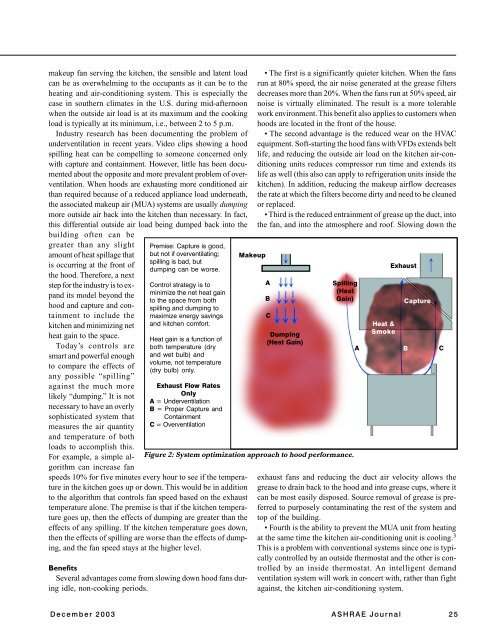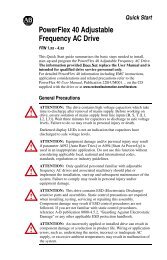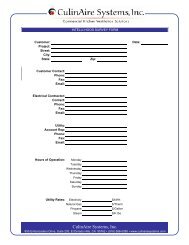ASHRAE - Kitchen Hoods, Using Demand ... - Culinaire Systems
ASHRAE - Kitchen Hoods, Using Demand ... - Culinaire Systems
ASHRAE - Kitchen Hoods, Using Demand ... - Culinaire Systems
Create successful ePaper yourself
Turn your PDF publications into a flip-book with our unique Google optimized e-Paper software.
makeup fan serving the kitchen, the sensible and latent load<br />
can be as overwhelming to the occupants as it can be to the<br />
heating and air-conditioning system. This is especially the<br />
case in southern climates in the U.S. during mid-afternoon<br />
when the outside air load is at its maximum and the cooking<br />
load is typically at its minimum, i.e., between 2 to 5 p.m.<br />
Industry research has been documenting the problem of<br />
underventilation in recent years. Video clips showing a hood<br />
spilling heat can be compelling to someone concerned only<br />
with capture and containment. However, little has been documented<br />
about the opposite and more prevalent problem of overventilation.<br />
When hoods are exhausting more conditioned air<br />
than required because of a reduced appliance load underneath,<br />
the associated makeup air (MUA) systems are usually dumping<br />
more outside air back into the kitchen than necessary. In fact,<br />
this differential outside air load being dumped back into the<br />
building often can be<br />
greater than any slight<br />
amount of heat spillage that<br />
is occurring at the front of<br />
the hood. Therefore, a next<br />
step for the industry is to expand<br />
its model beyond the<br />
hood and capture and containment<br />
to include the<br />
kitchen and minimizing net<br />
heat gain to the space.<br />
Today’s controls are<br />
smart and powerful enough<br />
to compare the effects of<br />
any possible “spilling”<br />
against the much more<br />
likely “dumping.” It is not<br />
necessary to have an overly<br />
sophisticated system that<br />
measures the air quantity<br />
and temperature of both<br />
loads to accomplish this.<br />
For example, a simple algorithm<br />
can increase fan<br />
Premise: Capture is good,<br />
but not if overventilating;<br />
spilling is bad, but<br />
dumping can be worse.<br />
Control strategy is to<br />
minimize the net heat gain<br />
to the space from both<br />
spilling and dumping to<br />
maximize energy savings<br />
and kitchen comfort.<br />
Heat gain is a function of<br />
both temperature (dry<br />
and wet bulb) and<br />
volume, not temperature<br />
(dry bulb) only.<br />
Exhaust Flow Rates<br />
Only<br />
A = Underventilation<br />
B = Proper Capture and<br />
Containment<br />
C = Overventilation<br />
speeds 10% for five minutes every hour to see if the temperature<br />
in the kitchen goes up or down. This would be in addition<br />
to the algorithm that controls fan speed based on the exhaust<br />
temperature alone. The premise is that if the kitchen temperature<br />
goes up, then the effects of dumping are greater than the<br />
effects of any spilling. If the kitchen temperature goes down,<br />
then the effects of spilling are worse than the effects of dumping,<br />
and the fan speed stays at the higher level.<br />
Benefits<br />
Several advantages come from slowing down hood fans during<br />
idle, non-cooking periods.<br />
Makeup<br />
• The first is a significantly quieter kitchen. When the fans<br />
run at 80% speed, the air noise generated at the grease filters<br />
decreases more than 20%. When the fans run at 50% speed, air<br />
noise is virtually eliminated. The result is a more tolerable<br />
work environment. This benefit also applies to customers when<br />
hoods are located in the front of the house.<br />
• The second advantage is the reduced wear on the HVAC<br />
equipment. Soft-starting the hood fans with VFDs extends belt<br />
life, and reducing the outside air load on the kitchen air-conditioning<br />
units reduces compressor run time and extends its<br />
life as well (this also can apply to refrigeration units inside the<br />
kitchen). In addition, reducing the makeup airflow decreases<br />
the rate at which the filters become dirty and need to be cleaned<br />
or replaced.<br />
• Third is the reduced entrainment of grease up the duct, into<br />
the fan, and into the atmosphere and roof. Slowing down the<br />
A<br />
B<br />
C<br />
Dumping<br />
(Heat Gain)<br />
Spilling<br />
(Heat<br />
Gain)<br />
Figure 2: System optimization approach to hood performance.<br />
Heat &<br />
Smoke<br />
Exhaust<br />
Capture<br />
A B C<br />
exhaust fans and reducing the duct air velocity allows the<br />
grease to drain back to the hood and into grease cups, where it<br />
can be most easily disposed. Source removal of grease is preferred<br />
to purposely contaminating the rest of the system and<br />
top of the building.<br />
• Fourth is the ability to prevent the MUA unit from heating<br />
at the same time the kitchen air-conditioning unit is cooling. 3<br />
This is a problem with conventional systems since one is typically<br />
controlled by an outside thermostat and the other is controlled<br />
by an inside thermostat. An intelligent demand<br />
ventilation system will work in concert with, rather than fight<br />
against, the kitchen air-conditioning system.<br />
December 2003 <strong>ASHRAE</strong> Journal 25




